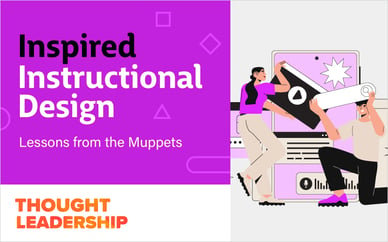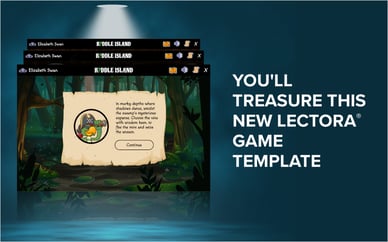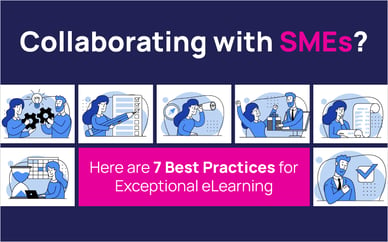
To create truly remarkable e-Learning courses that emotionally connect with your learners and help to relate to the subject matter, it's often beneficial to incorporate your personal interests and experiences in e-Learning course design. In this article, I'll discuss the many ways that you can take full advantage of the information you have already gathered thanks to your hobbies, personal interests and experiences.
How to Incorporate Your Personal Interests and Experiences in e-Learning Course Design
In many respects, e-Learning is a labor of love. As e-Learning professionals, we devote a great deal of our time and energy to creating e-Learning courses that instill knowledge and help others to improve their personal and professional lives. So, it's only natural that we would use every tool at our disposal, even the knowledge we have about our personal experiences and interests, to make e-Learning even more engaging, entertaining and educational for our audience. In this article, I'll share some tips that will help you to use your own personal experiences and interests in e-Learning course design and development.
1. Create stories and examples based upon your hobbies or personal interests and experiences.
Even if your e-Learning course has absolutely nothing to do with your personal interests and experiences or hobbies, you can still use them to your advantage when creating an e-Learning course. In fact, you can develop scenarios and examples based upon your passions that build an emotional connection with the learners. For example, you can create a scenario based on a personal story about how you went skydiving that ties into the learning objectives of the e-Learning course, or give them an example of a time when you went on a nature hike to stress the importance of developing a certain skill. Be symbolic and metaphoric if you need to direct learners' attention and create a connection between your personal interests and experiences and the subject matter they need to acquire. This makes it more personal, powerful and engaging for the learners, which helps them to effectively assimilate the information.
2. Develop e-Learning scenarios or simulations that capitalize on your personal knowledge.
You have something unique to offer your learners. You have knowledge, experience and insight into a particular topic that they can benefit from. So, why not create an interactive branching scenario or an e-Learning game that capitalizes on your personal knowledge and expertise? What can you offer them that they won't find in a textbook or in any other e-Learning course? When you determine the answer to this, tie it into an e-Learning scenario or simulation that walks them through a task or real life situation they might face. Again, when designing e-Learning courses you can tie virtually any personal interests and experiences into your subject matter if you look at it from a creative point of view.
3. Serve as a source of inspiration.
Ultimately, all e-Learning professionals want to inspire their learners. We want to motivate them to do their very best and to be their very best. We want our learners to get excited about the knowledge we are giving them and to be fully involved in their own learning process. To do this, we must serve as a source of inspiration. Our e-Learning course must fuel their desire to learn and enlighten them in a profound and unexpected way. So, when you're incorporating your interests or experiences into your e-Learning course, let the passion you have show. Serve as an example for them, to give them a glimpse at how education and the thirst for knowledge can pave the way to success in their lives, just as it has in yours.
4. Use your own feelings to stir their emotions.
When you think about your personal interests and experiences in e-Learning course design, chances are you feel strong emotions (to varying degrees). It's important to use these emotions to stir the emotions of your audience. Recount specific details that will help them feel the same way you did when hitting a ball for the first time or writing your first line of poetry. Make them feel so that they are better able to acquire and absorb knowledge by tying it to an emotional e-Learning experience.
5. Take them out of everyday life by creating an engaging environment.
One of the most amazing and powerful things about integrating personal interests and experiences into your e-Learning course design is that you are able to create an immersive and emotionally-centered environment for learners. They are given the opportunity to get away from the pressures and stresses of everyday life, so that they can truly participate in the e-Learning experience and get the most from the e-Learning course. It holds their attention and makes them see how learning the information will help them in the real world. So, when you're integrating your personal interests and experiences in e-Learning course design, keep in mind that the ultimate goal is to create an environment that is conducive to learning. Help them to forget everyday life for a bit, in order to expand their knowledge without any obstacles standing in the way. Include details that immerse them and make them feel like they are part of an unforgettable e-Learning experience.
6. Don't get too specific when incorporating personal interests and experiences in e-Learning course design.
Remember, not all members of your audience are fascinated by your personal interests. Just because you love painting doesn't mean that learners will want to pick up a brush the minute they complete your e-Learning course. This is why it's important to avoid being too specific when using your personal interests and experiences in e-Learning course design. You won't want to alienate members of your audience who don't feel the same way about your passions as you do, as this will make them disengage from the e-Learning experience and not get the full benefit from it. Use the inspiration and motivation you get from your personal interests and experiences to inspire and motivate your learners, but don't go overboard.
Use these tips to give your learners the gift of experience and first-hand knowledge by incorporating your interests and experiences, both personal and professional, when creating your next e-Learning course.







